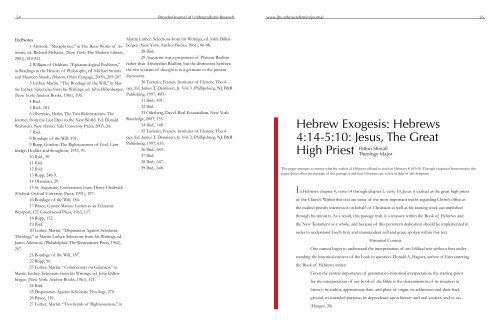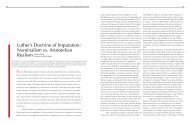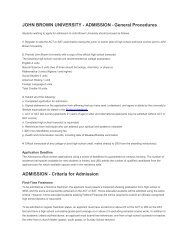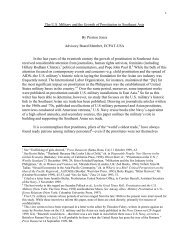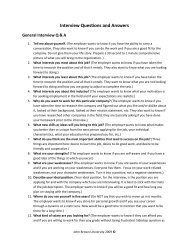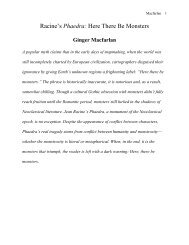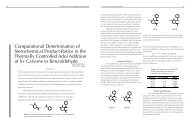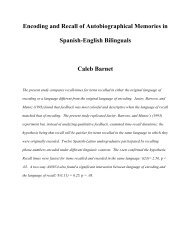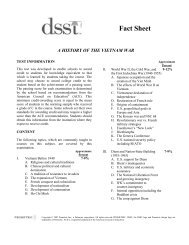Hebrews 4:14-5:10: Jesus, The Great High Priest Patton Shinall
Hebrews 4:14-5:10: Jesus, The Great High Priest Patton Shinall
Hebrews 4:14-5:10: Jesus, The Great High Priest Patton Shinall
- No tags were found...
You also want an ePaper? Increase the reach of your titles
YUMPU automatically turns print PDFs into web optimized ePapers that Google loves.
54Broaden Journal of Undergraduate Reseachwww.jbu.edu/academics/journal55EndNotes1 Aristotle. “Metaphysics,” in <strong>The</strong> Basic Works of Aristotle,ed. Richard McKeon, (New York: <strong>The</strong> Modern Library,2001), 8<strong>10</strong>-811.2 William of Ockham. “Epistemological Problems,”in Readings in the History of Philosophy, ed. Michael Strantzand Maureen Staudt, (Mason, Ohio: Cengage, 2009), 205-207.3 Luther, Martin. “<strong>The</strong> Bondage of the Will,” in MartinLuther: Selections from his Writings, ed. John Dillenberger,(New York: Anchor Books, 1961), 196.4 Ibid.5 Ibid., 181.6 Oberman, Heiko. <strong>The</strong> Two Reformations: <strong>The</strong>Journey from the Last Days to the New World. Ed. DonaldWeinstein. New Haven: Yale University Press, 2003, 24.7 Ibid.8 Bondage of the Will, 191.9 Rupp, Gordon. <strong>The</strong> Righteousness of God. Cambridge:Hodder and Stoughton, 1953, 91.<strong>10</strong> Ibid., 30.11 Ibid.12 Ibid.13 Rupp, 248-9.<strong>14</strong> Oberman, 29.15 St. Augustine, Confessions, trans. Henry Chadwick(Oxford: Oxford University Press, 1991), 197.16 Bondage of the Will, 184.17 Bruce, Gustav Marius. Luther as an Educator.Westport, CT: Greenwood Press, 1963, 117.18 Rupp, 152.19 Ibid.20 Luther, Martin. “Disputation Against Scholastic<strong>The</strong>ology,” in Martin Luther: Selections from his Writings, ed.James Atkinson, (Philadelphia: <strong>The</strong> Westminster Press, 1962),267.21 Bondage of the Will, 187.22 Rupp, 90.23 Luther, Martin. “Commentary on Galatians,” inMartin Luther: Selections from his Writings, ed. John Dillenberger,(New York: Anchor Books, 1961), 111.24 Ibid.25 Disputation Against Scholastic <strong>The</strong>ology, 270.26 Bruce, 119.27 Luther, Martin. “Two Kinds of Righteousness,” inMartin Luther: Selections from his Writings, ed. John Dillenberger,(New York: Anchor Books, 1961), 86-88.28 Ibid.29 Augustine was a proponent of Platonic Realismrather than Aristotelian Realism, but the distinction betweenthe two systems of thought is not germane to the presentdiscussion.30 Turretin, Francis. Institutes of Elenctic <strong>The</strong>ology.Ed. James T. Dennison, Jr. Vol. 3. Phillipsburg, NJ: P&RPublishing, 1997, 490.31 Ibid., 491.32 Ibid.33 Oderberg, David. Real Essentialism. New York:Routledge, 2007, 155.34 Ibid., <strong>14</strong>8.35 Turretin, Francis. Institutes of Elenctic <strong>The</strong>ology.Ed. James T. Dennison, Jr. Vol. 2. Phillipsburg, NJ: P&RPublishing, 1997, 635.36 Ibid., 643.37 Ibid.38 Ibid., 647.39 Ibid., 648.Hebrew Exogesis: <strong>Hebrews</strong>4:<strong>14</strong>-5:<strong>10</strong>: <strong>Jesus</strong>, <strong>The</strong> <strong>Great</strong><strong>Patton</strong> <strong>Shinall</strong><strong>High</strong> <strong>Priest</strong> <strong>The</strong>ology MajorThis paper attempts to answer what the author of <strong>Hebrews</strong> offered to teach in <strong>Hebrews</strong> 4:<strong>14</strong>-5:<strong>10</strong>. Through exegetical hermeneutics thispaper shows what the message of this passage is and how Christians are to live in light of this Scripture.In <strong>Hebrews</strong> chapter 4, verse <strong>14</strong> through chapter 5, verse <strong>10</strong>, <strong>Jesus</strong> is exalted as the great high priestof the Church. Within this text are some of the most important truths regarding Christ’s office asthe exalted priestly intercessor on behalf of Christians as well as his atoning work accomplishedthrough his ministry. As a result, this passage truly is a treasure within the Book of <strong>Hebrews</strong> andthe New Testament as a whole, and because of this persistent dedication should be implemented inorder to understand God’s holy and transcendent will and grace spoken within this text.Historical Context.One cannot begin to understand the interpretation of any biblical text without first understandingthe historical context of the book in question. Donald A. Hagner, author of Encounteringthe Book of <strong>Hebrews</strong> writes:Given the central importance of grammatico-historical interpretation, the starting pointfor the interpretation of any book of the Bible is the determination of its situation inhistory: its author, approximate date, and place of origin, its addressees and their background, its intended purpose, its dependence upon literary and oral sources, and so on(Hauger, 20).
56 Broaden Journal of Undergraduate Reseachwww.jbu.edu/academics/journal57Thus, without understanding these issues surrounding thetext, one would be unable to determine what God is attemptingto communicate through his word.<strong>The</strong> first issue to address is the authorship of thetext. Several authors have been suggested for <strong>Hebrews</strong> suchas: Paul, Clement of Rome, Barnabas, Apollos, Luke, Silas,Epaphras, and Priscilla. 2 Though some of the possible authorsmentioned are more likely than others, the fact remains that itis impossible to know who the author truly is, with absolutecertainty, on this side of heaven. Origen said it best whenspeaking of <strong>Hebrews</strong>, “[b]ut who wrote the epistle, in truthGod knows.” 3 However, it is possible to understand certainaspects about author from the text itself. 4 For instance, theauthor was clearly well-versed in Old Testament scriptures,and presented an “obviously christocentric hermeneutic” ininterpreting them. 5 <strong>The</strong> responsible individual was probablyacquainted with Paul’s teachings. 6 Furthermore, the writermust have had “sophisticated rhetorical training and literaryskills” and superior learning in Greek, resulting in “the bestGreek style in the New Testament.” 7 <strong>The</strong> person was alsoobviously well educated by Hellenistic standards. 8 Lastly, theauthor was almost certainly a Jew, demonstrated by knowledgeof the Jewish temple expounded upon in the text. 9<strong>The</strong> author’s use of temple terminology allows foran appropriate understanding of the date of <strong>Hebrews</strong>. <strong>The</strong>Jewish temple was destroyed in AD 70, but the writer of<strong>Hebrews</strong> makes no reference to such catastrophe, insteadclaiming in <strong>Hebrews</strong> 8:13 that “what is obsolete and growingold will soon disappear.” <strong>10</strong> Such a statement suggsts that theauthor had no knowledge of the temple’s destruction, andthus, although certain scholars disagree, it can be deduced that<strong>Hebrews</strong> was written before the Fall of Jerusalem in AD 70. 11<strong>The</strong> next issue to be addressed regarding date is to determineexactly when <strong>Hebrews</strong> was written before the destruction ofthe temple. According to Hagner, this, in large part, rests ondetermining the persecution mentioned in <strong>Hebrews</strong> <strong>10</strong>:32-34. 12 In <strong>Hebrews</strong> 12:4 the persecution aforementioned ismore clearly defined, in that, the audience of <strong>Hebrews</strong> hasyet to shed blood in their struggle. 13 Hagner also asserts thataccording <strong>Hebrews</strong> 2:3, the author and audience were secondgeneration Christians. <strong>14</strong> After all of the preceding data is takeninto consideration, it is reasonable to argue that the date of<strong>Hebrews</strong> is placed in the 60’s and probably before AD 64, afterwhich the Romans shed Christian blood like never before,a scenario not likely in light of <strong>Hebrews</strong> 12:415. 15<strong>The</strong> audience, much like the author, is also ambiguoussince the usual epistolary opening is not given in the beginningof the letter. 16 Hagner surmises that…the book’s sustained argument clearly seems tosuggest readers of Jewish background. <strong>The</strong>y[the audience], far more than any others, would findpressing upon them the question of the relationbetween the old and new covenants, and they, morethan any, might be attracted to their previous modeof life. 17I agree with Hagner that the original audience of <strong>Hebrews</strong>were Jewish Christians, mainly because of the complex Jewishideas, as well as, the immense use of Old Testament textsfound within the book. More specifically, the Jewish Christiansto which the letter was addressed probably had a backgroundwithin a Hellenistic synagogue. 18 <strong>The</strong> reading of <strong>Hebrews</strong>requires so much Jewish knowledge that it seems improbablefor any common person, to whom the letter may have beenintended for, to not have a Jewish background. F. F. Bruce, agreat scholar on the book of <strong>Hebrews</strong>, concludes regardingthe text, “<strong>The</strong> whole argument is conducted against a backgroundof Old Testament allusion; considerable familiaritywith the Levitical ritual and interest in it.” 19 Though Bruceacknowledges that this fact alone does not necessitate the needfor a Jewish audience, he argues that the author’s persistentdisplay of the inadequacy of the law suggests that his readerswere, at one point, Jews who were required to live under thelaws requirements. 20Based on the text, it can be understood that the JewishChristians to whom the letter of <strong>Hebrews</strong> was writtenseem to be in a crisis in which they are tempted to turn awayfrom their Christian faith towards Judaism once again. 21 Thistemptation most likely arises out of pressure from the synagogueor, perhaps, the persecution of Christians at the handsof Gentiles. 22 <strong>The</strong> persecution aforementioned is evidenced bythe author’s repeated exhortations for the audience to perseverein their faith so that they may enter into God’s rest. 23 <strong>The</strong>audience in question was, most likely, undergoing public abuse,imprisonment and loss of property, and thus was tempted towaver in their Christian faith. 24 Despite the understanding thatthe audience was most likely comprised of Jewish Christians,it is still uncertain as to where the audience lived (Hagner 24).One clue which aides in the understanding of the destinationof the letter occurs at the end of the book, in <strong>Hebrews</strong> 13:24where it says, “Those from Italy send you greetings.”Hagnerholds the position that “the letter was addressed to a community,or communities, in Rome, and that those from Italywho were with the author wished to be remembered to theircompatriots.” 25 Thus, he and other major scholars believeit is more natural for the audience to be located in Romerather than the author. 26 Hagner demonstrates this argumentfrom <strong>Hebrews</strong>. In 6:<strong>10</strong> and <strong>10</strong>:32-34 the writer appeals to thegenerosity of the readers, a characteristic known to be true ofthe Roman church, and to “the persecution of former days,”which could refer to the expulsion of the Jews from Rome inAD 49. This expulsion would have occurred during Claudius’sreign or Nero’s persecution of Christians in AD 64. 27 On theother hand, other scholars have rejected the notion that theaudience dwelled in Rome, finding no real evidence for sucha notion. 28 In regards to the destination of the letter, Brucesimply states, “Where did they live? We do not know.” 29Despite the plethora of ambiguity surrounding <strong>Hebrews</strong>,one aspect of the book is undeniably clear due to proof foundfrom within the text itself. <strong>The</strong> overall purpose of <strong>Hebrews</strong>,in my opinion, is to encourage Jewish Christians to continueenduring in their faith. <strong>The</strong> author himself describes hisletter as “my word of exhortation” in <strong>Hebrews</strong> 13:22. <strong>The</strong>writer encourages readers to endure by expounding upon “theincomparable superiority, and hence finality, of God’s workin <strong>Jesus</strong> Christ.” 30 <strong>The</strong>refore, the purpose of <strong>Hebrews</strong> can bedescribed as an encouragement to endure in Christ because<strong>Jesus</strong> is the only way and superior to all other teachings of theworld.Passage Context: BeforeNow that the historical context of <strong>Hebrews</strong> as awhole has been examined, the next step is to understand thecontext of <strong>Hebrews</strong> 4:<strong>14</strong>-5:<strong>10</strong> within the book as a whole. In<strong>Hebrews</strong> chapter 1 through the first half of chapter 3, the authordiscusses the Messiah’s superiority to angels and Moses.<strong>The</strong>n the author begins discussing God’s rest for his peoplein <strong>Hebrews</strong> 3:7. <strong>The</strong> writer continues this thought of strivingto enter into God’s holy rest through <strong>Hebrews</strong> 4:13 leading tothe chapter regarding <strong>Jesus</strong> as the great high priest by whomthe believers are enabled to enter God’s rest in <strong>Hebrews</strong> 4:<strong>14</strong>-5:<strong>10</strong>.Exegesis4:<strong>14</strong><strong>Hebrews</strong> chapter 4, verse <strong>14</strong> through chapter 5, verse<strong>10</strong> begins by introducing “a great high priest,” effectivelyintroducing the entire premise of this passage. 31 Continuing in<strong>Hebrews</strong> 4:<strong>14</strong>, the author specifies who this great high priestis by identifying him as the one “who has passed throughthe heavens, <strong>Jesus</strong>…” God the Father and God the Son arerepresented in this verse when the author identifies <strong>Jesus</strong>explicitly as “the Son of God.” 32 Thus, in the first portion ofthis verse, the writer has introduced <strong>Jesus</strong>, who is the Son ofGod, as the “great high priest who has passed through theheavens…” 33 <strong>The</strong> author then states “[l]et us hold fast toour confession,” which is the response that the writer desiresfrom the audience upon understanding that <strong>Jesus</strong> is its greathigh priest. 34 This is demonstrated by the author’s use of theGreek, “Ἔχοντες οὖν.” It is important to note that all of thefollowing Greek quotations come from the NA27, and allsubsequent translations are from my own study of the Greektext. “Ἔχοντες is the present active masculine nominativeplural participle, which literally means “having,” and οὖν is apostpositive, meaning “therefore” or “consequently”. In lightof such an understanding of the words, the author is literallysaying “Having, therefore, a great high priest…let us hold fastto our confession.” Such a statement effectively gives a specificresponse to a specific situation presented to the audience,“hold[ing] fast to our confession” because “we have a greathigh priest,” a relationship which can be plainly seen by usingDiscourse Analysis. 354:15<strong>The</strong> author then moves in verse 15 to further expoundupon the high priest that both he and the audienceshare, “[f]or we do not have a high priest who is unable tosympathize with our weaknesses.” 36 <strong>The</strong> author has alreadyidentified the high priest, whom he is speaking of, as “<strong>Jesus</strong>,Son of God,” and the writer continues to label the high priestas one who is able to sympathize with the weaknesses ofthe people. 37 It is interesting to note that συμπαθέω 38 is onlyfound twice in the New Testament, with the second use in<strong>Hebrews</strong> <strong>10</strong>:34. 39 <strong>The</strong> other use of this word is translated as“compassion,” 40 or “to understand, have the ability to relateto the emotions of another, or to feel for.” 41 As a result, theauthor tells his audience that they have a high priest who isable to understand or relate to their weaknesses. <strong>The</strong> writer
58 Broaden Journal of Undergraduate Reseachwww.jbu.edu/academics/journal59then expounds, “but we have one who in every respect hasbeen tested as we are yet without sin”, making a clear anddeliberate movement from the beginning of verse 15. 42 <strong>The</strong>author moves from a negative statement to a positive statement.<strong>The</strong> author previously said that he and the audience didnot have a high priest who could not sympathize with theirweaknesses and follows with a proposal that they do possessin their high priest “one who in every respect has been testedas [they] are.” 43 Additionally, this testing is the reason why<strong>Jesus</strong> is able to sympathize with the audience’s human weakness.<strong>The</strong> author then ends this sentence by further sheddinglight on <strong>Jesus</strong>, the high priest, as one who was tested “yet [was]without sin.” 444:16In <strong>Hebrews</strong> chapter 4, verse 16, the author presentsa response to the high priestly ministry of <strong>Jesus</strong> when heuses the verb προσερχώμεθα, 45 which is the present middlesubjunctive first person plural of προσερχομαι. Προσερχομαιliterally means “I come to, go to, or approach,” and so, whenused in the first person plural subjunctive, it translates “let uscome to or approach.” Thus the author says, “[l]et us thereforeapproach the throne of grace with boldness, so that wemay receive mercy and find grace to help in time of need.” 46Essentially, the writer is conveying “[s]ince, then, we have agreat high priest…who in every respect has been tested as weare, yet without sin…Let us therefore approach the throneof grace with boldness.” 47 Furthermore, by approaching thethrone of grace, the author says that believers will receive theaid of mercy and grace in time of need. At this point, thewriter makes his first major break in the passage. In these verses,he has written somewhat of an introduction to the ideaswhich he will then move to discuss in verse 5 through the endof the passage.5:1<strong>Hebrews</strong> chapter 5, verses 1 through <strong>10</strong> demonstratea chiasm. 48 <strong>The</strong> chiasm which the author uses is this:A. <strong>The</strong> old office of high priest (5:1)B. <strong>The</strong> solidarity of the high priest with thepeople (5:2-3)C. <strong>The</strong> humility of the high priest (5:4)C.1 <strong>The</strong> humility of Christ (5:5-6)B.1 <strong>The</strong> solidarity of Christ with the people (5:7-8)A.1 <strong>The</strong> new office of high priest (5:9-<strong>10</strong>) 49As demonstrated by the chiastic structure given above, <strong>Hebrews</strong>5:1-<strong>10</strong> compares the high priestly ministry of the Jewishhigh priest, and that of <strong>Jesus</strong>, the great high priest.Verse 1 discusses the office of high priest itself. Itsays that every high priest is chosen by God “from amongmortals,” and this identifies the high priest of whom theauthor is speaking as a mortal himself. <strong>The</strong> high priest whomGod chooses “is put in charge of things pertaining to Godon their [mortals] behalf.” 50 Thus, the author recognizes thatthe high priest serves as a mediator between God and mortals.More specifically, the author continues to succinctly mark theduties which the high priest performs on behalf of mortalsunto God, that is, “to offer gifts and sacrifices for sins.”5:2In verse 2, the author moves from describing the highpriest’s relationship with mortals on behalf of God to hisrelationship with the mortals themselves. <strong>The</strong> passage says,“[h]e [the high priest] is able to deal gently with the ignorantand wayward, since he himself is subject to weakness.” 51 <strong>The</strong>author identifies the mortal high priest as one who is ableto be kind and merciful to those who make mistakes. However,the writer clarifies that the mortal high priest is himself“subject to weakness.” 52 It is the very fact that the high priestfaces temptation which gives ground to the author’s precedingstatement qualifying the high priest to “deal gently with theignorant and the wayward.” 53 It is also of interest to note theauthor’s comparison from <strong>Hebrews</strong> 5:15 in which the writerstated that <strong>Jesus</strong>, like the high priest in <strong>Hebrews</strong> 5:2, is able tosympathize with sinners, but, unlike the high priest, <strong>Jesus</strong> waswithout sin.5:3<strong>The</strong> author continues in <strong>Hebrews</strong> chapter 5, verse 3,saying, “καὶ δι’ αὐτὴν ὀφείλει καθὼς περὶ τοῦ λαοῦ οὕτωςκαὶ περὶ αὐτοῦ προσφέρειν περὶ ἁμαρτιῶν” which translatedliterally means “and because of this he is obligated to offersacrifices for sins just as for the people.” <strong>The</strong> author uses thephrase “καὶ δι’ αὐτὴν,” or “and because of this,” and thus,argues that the effect of the high priest himself being subjectto weakness is that “he must offer sacrifice,”not only for thesin of the people who have been identified as “the ignorantand wayward, 54 but also “for his own sins” 55 . <strong>The</strong> verb usedfor “offer” found in this verse is the infinitive of προσφέρω. 56<strong>Hebrews</strong> uses this verb more than any other book in the NewTestament. Προσφέρω 57 can mean “to bring to,” “offer,” orother variations of these basic definitions, and is most commonlyrelated to sacrifices.5:4<strong>Hebrews</strong> chapter 5, verse 4 concludes the author’s discussionof the office of the mortal high priest, “one does notpresume to take this honor, but takes it only when called byGod, just as Aaron was.” <strong>The</strong> reader can glean two key pointsfrom this verse regarding the office of high priest. <strong>The</strong> firstis that the high priest receives honor for holding the position.<strong>The</strong> second point the author makes is that no person can takehold of this honor: God directly calls individuals to be highpriests. <strong>The</strong> writer then presents the example of God callingAaron to be a priest. With this in mind, the author then movesin the next verse to discuss <strong>Jesus</strong>’ ministry as the great highpriest.5:5-6Following the chiastic structure, the author directlycompares <strong>Jesus</strong>’ appointment to high priest in <strong>Hebrews</strong> 5:5with the preceding statements in 5:4. It says, “So also Christdid not glorify himself in becoming a high priest, but wasappointed…” Thus, just as the mortal high priests, Christ didnot take hold of the honor of high priest for himself, but, asthe word says, was appointed. Continuing, the author quotesPsalm 2:7 and interprets it through sensus plenior to identifythat Christ was appointed a high priest “by the one who saidto him, ‘You are my Son, today I have begotten you’…” 58Once again, as already mentioned from <strong>Hebrews</strong> 4:<strong>14</strong>, theFather and the Son are both identified in this verse. It cansafely be determined that God the Father is the one mentionedbased on the Old Testament quote the author giveswhen he says, “You are my Son…” Chapter 5, verse 6 quotesanother Old Testament scripture, Psalm 1<strong>10</strong>, in which theFather is speaking to the Son saying, “You are a priest forever,according to the order of Melchizedek.” Thus God designatesChrist as a priest whose office is forever, giving foundationto this appointment with the words, “according to the orderof Melchizedek.” It is important to note that the author alsoreceives all of his midrashic quotations from the Septuagintinstead of the original Hebrew texts themselves 59 .5:7<strong>Hebrews</strong> chapter 5, verse 7 discusses the life of <strong>Jesus</strong>while he was in his flesh. <strong>The</strong> scripture says that he “offeredup prayers and supplications with loud cries and tears.” <strong>The</strong>author again uses a form of προσφέρω for the second time infour verses. <strong>The</strong> prayers which <strong>Jesus</strong> offered were “to the onewho was able to save him from death,” and furthermore, theauthor says that Christ’s prayers were heard. <strong>The</strong> reason theWord says that <strong>Jesus</strong>’ prayers were heard was “because of hisreverent submission.”5:8-<strong>10</strong>Verses 8 through 9 continue. “Although he [<strong>Jesus</strong>] wasa Son, he learned obedience through what he suffered, andhaving been made perfect, he became the source of eternalsalvation for all who obey him…” From these two versesit can be seen that <strong>Jesus</strong> is designated as the source, or thefoundation, of eternal life for everyone who obeys him. <strong>The</strong>text reveals that the reason why Christ became the source ofeternal salvation to all is that he was obedient in his sufferingand in his suffering he was made perfect. This obedience isalso referred to in Philippians 2:8 which says, “[<strong>Jesus</strong>] humbledhimself and became obedient to the point of death – evendeath on a cross.” Thus, Christ was made perfect in his obedientsuffering from enduring his cross. Philippians chapter 2,verse 9 continues, “<strong>The</strong>refore God also highly exalted him andgave him the name that is above every name…” <strong>Hebrews</strong> 5:<strong>10</strong>continues to explain this. <strong>The</strong> author then concludes the passagein verse <strong>10</strong> much like he began, saying that Christ is thegreat high priest who has “been designated by God accordingto the order of Melchizedek.” <strong>The</strong> verb translated as “designated,”“προσαγορευθεὶς,” is the aorist passive participle ofπροσαγορεύω. 60 <strong>Hebrews</strong> chapter 5, verse <strong>10</strong> marks the onlyoccurrence of this verb in the entire New Testament. 61 It canbe translated as “call. 62 Thus, the author of <strong>Hebrews</strong> says thatChrist was explicitly called by God to be a high priest, justas all other high priests were, 63 but with the unique distinctionthat Christ is a “high priest according to the order ofMelchizedek”, 64 which, as the author said in <strong>Hebrews</strong> 5:6,designates him as a priest forever.Overall, this passage in <strong>Hebrews</strong> is one of the mostconcise arguments found within the entire letter, and as aresult, it reads very much like a sermon. In fact, it is as if thewriter of <strong>Hebrews</strong> is literally preaching the very words hewrote. I recognize that there are more observations, as well ascanonical comparisons, to be made from this passage regardingthe actual effect that the high priestly ministry of <strong>Jesus</strong>has on the Christian, but I will delay in discussing these untilproper interpretations have been made regarding the passageso that the full weight of the author’s argument can be trulyunderstood.
60 Broaden Journal of Undergraduate Reseachwww.jbu.edu/academics/journal61HermeneuticsAfter examining the content of the text and mannerin which it the author presents it, the next step in understanding<strong>Hebrews</strong> 4:<strong>14</strong>-5:<strong>10</strong> is to interpret what God has spokenin the Logos in order to effectively understand the Pathos, orintended effect, desired from this passage, and as a result, theEthos, God’s will, behind the passage.<strong>Hebrews</strong> 4:<strong>14</strong> – “Since, then, we have a great high priest whoas passed through the heavens, <strong>Jesus</strong>, the Son of God, let ushold fast to our confession.”Since <strong>Hebrews</strong> 4:<strong>14</strong>-5:<strong>10</strong> deals with the high priestlyministry of Christ, and ἀρχιερεύς, which means high priest,is used in variations five times within this portion of scripturealone, it is pertinent to understand the role of the highpriest within the Jewish religious system. Believers need tounderstand such a role so that they can fully understand andappreciate <strong>Jesus</strong>’ high priestly ministry. Though the author of<strong>Hebrews</strong> unpacks the basic understanding of the high priest inchapter 5, verses 1 through 4, it is helpful to undergo a shortsurvey of the high priest.To begin, the high priest is the head of all priestlyaffairs for the Jewish people, 65 and as a result, he had stricterrites of purity laid upon him than the rest of the priests. 66Also known as the chief priest, the high priest was a “mediatorbetween Yahweh and the people of Israel…” 67 <strong>The</strong> mostimportant role the high priest performed was his set of dutieson the Day of Atonement, as found in Leviticus 16, becausethe high priest was absolutely essential to its celebration. <strong>The</strong>Day of Atonement was celebrated on the tenth day of the Hebrewmonth of Tishri on which the Israelites celebrated God’sremoval and forgiveness of Israel’s sin. First, the high priestwould sacrifice a goat that was chosen by lot from a pair ofgoats for the sins of Israel. Upon sacrificing the first goat, thehigh priest would then take the second goat, lay his hand uponits head, and confess the sins of the people. This scapegoatwas then chased into the wilderness and killed, taking with itIsrael’s guilt of sin. 68 Also, the high priest alone who was ableto enter the Holy of Holies, but even then only on the yearlyDay of Atonement. 69 <strong>The</strong> Day of Atonement is an importantconcept to the author of <strong>Hebrews</strong> as he introduces the superiorityof <strong>Jesus</strong>’ high priesthood.<strong>The</strong> great biblical scholar William L. Lane asserts thatin this passage of <strong>Hebrews</strong> the “writer takes up the assertionthat <strong>Jesus</strong> is a ‘merciful high priest in the service of God.’” 70Lane is completely right because as verse <strong>14</strong> says, the authorintroduces that <strong>Jesus</strong> is the great high priest for Christians.<strong>The</strong> Book of <strong>Hebrews</strong> is the only book in the entire NewTestament where <strong>Jesus</strong> is referred to as “high priest.” 71 When<strong>Jesus</strong> is referred to as ἀρχιερέα μέγαν, “a great high priest,”μέγαν signifies the grandeur and superiority of his priestlyministry. 72 Along with being referred to as a great high priest,<strong>Jesus</strong> is also explicitly identified as the Son of God 73 , a namewhich famous Reformer, John Calvin, describes as possessing“such majesty as ought to constrain [Christians] to fear andobey him.” 74 Thus this title gives further support to the superiorityof Christ over the old Jewish system, a major theme in<strong>Hebrews</strong>. 75Not only is <strong>Jesus</strong> the great “high priest of our confession,”76 but he is also the high priest “who has passed throughthe heavens.” 77 <strong>The</strong> exact meaning of this phrase is ratherdifficult to determine. Hagner leaves open the possibility thatthis phrase is a reference to Psalm 1<strong>10</strong>:1 78 which says, “<strong>The</strong>Lord says to my Lord, ‘Sit at my right hand until I make yourenemies your footstool.” This seems to be the position ofEdward William Fudge, author of <strong>Hebrews</strong>: Ancient Encouragementfor Believers Today, because he writes that <strong>Jesus</strong> “haspassed through the heavens to God’s right-hand and place ofhonor…” 79 Yet another position on the exact interpretationof this phrase states that it is an affirmation of the bodilyascension of Christ. 80 Though there are several other theoriesthat have been presented regarding this text, I hold that thephrase “who has passed through the heavens” most likely affirmsa combination of the two aforementioned ideas, in that,<strong>Jesus</strong> has ascended into the heavens, and is exalted above all asEphesians 4:<strong>10</strong> declares, 81 but that this phrase also alludes to<strong>Jesus</strong>’ ministry in comparison with the sacrifice made on theDay of Atonement.This phrase is also coupled with terms regarding thesacrifice of the temple. 82 F.F. Bruce, one of the greatest NewTestament scholars to ever comment on the Book of <strong>Hebrews</strong>,further explains the inclusion of the temple sacrifice byacknowledging the difference between the mortal high priestand the great high priest, <strong>Jesus</strong>. Just as the high priest wouldpass through the veil to enter the Holy of Holies to offersacrifices on the Day of Atonement, so also did Christ passthrough the heavenly veil to enter the true heavenly sanctuaryon Christian’s behalf. 83 As a result, the author reminds hisreaders that the high priest was only permitted to enter theHoly of Holies once a year but asserts that, with Christ as theChristian high priest, believers are enabled to cling to theirconfession perpetually 84 because of the “efficacy and finalityof [<strong>Jesus</strong>’] atoning work before the very presence of God inthe true or heavenly sanctuary.” 85 It is because Christ sits at theright hand of the Father as a mediator on behalf of the Saintsthat believers have every reason to cling fast to their confession.86<strong>Hebrews</strong> 4:15 - “For we do not have a high priest who isunable to sympathize with our weaknesses, but we haveone who in every respect has been tested as we are, yetwithout sin.”<strong>The</strong> text now moves on to further identify the highpriest Christians have in <strong>Jesus</strong>. <strong>The</strong> author proclaims, “we donot have a high priest who is unable to sympathize with ourweaknesses…” 87 As stated, the verb translated as “sympathize,”συμπαθέω, literally means “to feel for.” 88 In light ofthis translation, <strong>Hebrews</strong> 4:15 serves as a comfort for Christianswho struggle with sin because it presents <strong>Jesus</strong>, not as animpatient old man who grows tired of the constant struggleof saints with sin, but rather an understanding and empatheticSavior who can understand the weaknesses of the Saintsthrough his incarnation. Bruce makes a profound statementregarding <strong>Jesus</strong>, the heavenly high priest, saying, “Christianshave in heaven a high priest with an unequaled capacity forsympathizing with them in all the dangers and sorrows andtrials which come their way in life, because he himself, byvirtue of his likeness to them, was exposed to all these experiences”89 When commenting on this verse, Photius wrote that<strong>Jesus</strong> “as very man suffered and endured the testing of afflictionsand the weaknesses of the flesh…he is in every respectmade a partaker of our weaknesses.” 90 It is this idea thatChrist has been made a partaker in the weaknesses of the fleshthat the author had already mentioned in <strong>Hebrews</strong> 2:17 saying,“<strong>The</strong>refore he had to become like his brothers and sisters inevery respect, so that he might be a merciful and faithful highpriest in the service of God, to make a sacrifice of atonementfor the sins of the people.” <strong>The</strong> writer also presents the reasonthat Christ is able to sympathize with the Saints’ weaknesseswhen he says that <strong>Jesus</strong> “has been tested as we are…” 91 Again,the author had already mentioned this in <strong>Hebrews</strong> 2:18 whenhe said, “Because he himself was tested by what he suffered,he is able to help those who are being tested.” In other words,according to <strong>Hebrews</strong> 4:15, since <strong>Jesus</strong> has been tested as theSaints were, he is able to sympathize with their weaknesses. Itis important to note that this verse does not mean that Christexperienced the temptation of every single sin, but instead, heunderwent the testing of every basic temptation. 92Though Christ was “in every respect…tested as we are,” 93the author clearly makes the distinction that, unlike humans,he was without sin. <strong>The</strong> fact that <strong>Jesus</strong> was without sin in noway diminishes his humanity, but rather supports it because<strong>Jesus</strong> perfectly embodied what God intended for humanityfrom the beginning of creation. 94 In Genesis, the man and thewoman were fully human and created without sin prior to thefall. 95 So also Christ, “the last Adam,” 96 was “fully human butwithout sin.” 97 It is by his sinlessness in the incarnation that<strong>Jesus</strong> “opens up the way to God,” 98 a point <strong>Hebrews</strong> proudlyaddresses in chapter 4, verse 16.<strong>Hebrews</strong> 4:16 – “Let us therefore approach the throne ofgrace with boldness, so that we may receive mercy and findgrace to help in time of need.”<strong>The</strong> author concludes his introduction with theoverall response that the believer should have to his addressregarding <strong>Jesus</strong> as the great, sympathizing, and sinless highpriest. <strong>The</strong> author compels his audience towards the mercyof <strong>Jesus</strong> saying, “Since, then, we have a great high priest…Letus therefore approach the throne of grace with boldness…” 99In regards to the throne of grace, Chrysostom identifies it asthe very same throne in Psalm 1<strong>10</strong>:1. Chrysostom continuesacknowledging that Christians are able to approach the throneof God with boldness because it is no longer a throne ofjudgment, but of grace <strong>10</strong>0 where the Saints “may receive mercyand find grace to help in time of need.” <strong>10</strong>1<strong>The</strong> reason that God’s throne has become a throneof grace is because <strong>Jesus</strong> is the “sympathetic high priest inheaven.” <strong>10</strong>2 Since it is for this reason that Christians are ableto approach a throne of grace, it would be irresponsible toignore the high priestly connection with the author’s choice ofwords regarding the throne. Like Chrysostom, Bruce identifiesthe throne of grace as “the throne of God, where <strong>Jesus</strong>, as hispeople’s high priest, sits exalted at the father’s right hand.” <strong>10</strong>3He goes on to identify the throne of grace as an antitype tothe “mercy-seat” found in the earthly sanctuary. <strong>10</strong>4 In furtherexpounding upon the mercy-seat, Bruce says it best that “itwas at the earthly mercy-seat that the work of atonement was
62 Broaden Journal of Undergraduate Reseachwww.jbu.edu/academics/journal63completed in token on the Day of Atonement and the graceof God extended to his people.” <strong>10</strong>5 On the Day of Atonement,the high priest would enter into the Holy of Holies toapproach the throne of grace which was the altar or on thealtar found behind the veil so that he might offer the people’ssacrifice. <strong>Jesus</strong> took a unique approach to the throne ofgrace as he himself was the offering. <strong>10</strong>6 Thus, “the presenceof the Christians’ high priest on the heavenly throne of gracebespeaks a work of atonement completed not in token butin fact.” <strong>10</strong>7 Hagner even acknowledges that “what <strong>Jesus</strong> didthrough his death on the cross was seen as the goal and fulfillmentof the sacrificial ritual performed by the high priest onYom Kippur” <strong>10</strong>8It is by this completed atonement that Christiansare able to approach the mercy-seat in boldness. Under theold sacrificial system, only the high priest was permitted toapproach the throne of grace on Yom Kippur, and sincethe offering, namely <strong>Jesus</strong>, had already “passed through theheavens,” <strong>10</strong>9 “believers were reconciled [of their sins], nolonger kept at a distance, but invited to ‘approach the throneof grace with boldness.’” 1<strong>10</strong> One commentator even notesthat παρρησία, 111 meaning boldness, can be understood in<strong>Hebrews</strong> as “the unquestioned right to approach God.” 112Thus, through the atoning work of Christ, Christians mayapproach the throne of grace at any time to “receive mercyand find grace to help in time of need.” 113 Bruce even says “[t]hanks to [<strong>Jesus</strong>], the throne of God is a mercy-seat to which[Christians] have free access and from which [Christians] mayreceive all the grace and power required ‘for timely help’ inthe hour of trial and crisis” 1<strong>14</strong> all because <strong>Jesus</strong> is the great andsympathetic high priest for the saints.In order to bring about the full weight of the implicationsheld by <strong>Jesus</strong>’ high priestly ministry, the author comparesthe Jewish high priest’s ministry with that of <strong>Jesus</strong>’ superiorministry as the eternal high priest through the chiasm found in<strong>Hebrews</strong> 5:1-<strong>10</strong>.5:1 – “Every high priest chosen from among mortals is put incharge of things pertaining to God on their behalf, to offergifts and sacrifices for sins.”<strong>Hebrews</strong> chapter 5, verses 1 through 4 lays thefundamental understanding of the office of high priest. <strong>The</strong>author begins with, “Every high priest chosen from amongmortals” 115 <strong>The</strong> first point that the author makes note of isthat the high priest was chosen specifically by God. Oncechosen, the high priest was “put in charge of things pertainingto God” 116 on behalf of the people. <strong>The</strong>refore, the functionof the high priest was to serve as a mediator between humanbeings and God, “straddling the gap between heaven andearth.” 117 <strong>The</strong> high priest acted as an intercessor by offering“gifts and sacrifices for sins” 118 committed by the people. 119Though it is natural to separate the gifts and the sacrifices asindividual offerings, 120 the author uses these as a general expressionfor offerings themselves. 121 <strong>The</strong> author does specifythat these offerings were specifically offered for sins, and so,“were the sin and guilt offerings.” 122 Even more specifically,the author later identifies the particular sin and guilt offeringswhich he has in mind as those of the Day of Atonement, 123and thus, Leviticus 16 is an immensely important passage inunderstanding the author’s argument that <strong>Jesus</strong> is the superiorhigh priest not only in this passage, but in all of <strong>Hebrews</strong>.passage in understanding the author’s argument that <strong>Jesus</strong> isthe superior high priest not only in this passage, but in all of<strong>Hebrews</strong>.<strong>Hebrews</strong> 5:2 – “He is able to deal gently with the ignorant andthe wayward, since he himself is subject to weakness;”As the author continues his exposition of the highpriest’s religious duties, he rests on the humanity of the highpriest in <strong>Hebrews</strong> 5:2-3. Hagner accurately surmises that the“humanity of the high priest is very important because itenables him to work gently with the wayward and the weak.” 124Regarding this, Thomas G. Long, author of Interpretation:<strong>Hebrews</strong>, proposes that high priests were “not merely liturgicalfunctionaries,” but were also pastors. He presents thisargument on the basis that the high priests needed to be “acompassionate people,” 125 thus enabling them to effectivelydeal with the sinful people they interceded for.<strong>The</strong> author gives the evidence why the high priest “is able todeal gently with the ignorant and wayward” in the subsequentphrase stating that the “[high priest] himself is subject toweakness.” 126 “Because the old high priests were also ordinaryhuman beings, their own weaknesses and failings enabledthem to be sympathetic and to treat confused and sinfulpeople with gentleness and understanding” 127 <strong>The</strong> writer usesthe word περίκειται, translated as “subject to,” as a clever punsince it is also able to be translated as “clothed.” 128 Exoduschapter 28, verses 2 through 39 exhaustively details the specialclothes which were worn by the high priest (NRSV). This garbclothes which were worn by the high priest. This garb consistedof “a robe or outer garment, an ephod, breastplate,coat or undergarment, turban, and girdle.” 129 <strong>The</strong>se clothesset apart the high priest from common men. <strong>The</strong> author is,thus, using clever irony to display his point that the priest is“also ‘clothed’ with moral weakness like every other citizen ofIsrael,” 130 aligning the high priest with the people and enablinghim to be understanding and sympathetic towards sinners justas <strong>Jesus</strong> is in <strong>Hebrews</strong> 4:15.<strong>Hebrews</strong> 5:3 – “…and because of this he must offer sacrificefor his own sins as well as for those of the people.”Since the high priest is “every bit as sinful” 131 as thepeople whom he interceded and offered sacrifices for, “hemust offer sacrifice for his own sins as well as for those ofthe people.” 132 On the Day of Atonement, the high priest wasrequired to make a sacrifice “for himself, for his immediatehousehold, as well as for the congregation of Israel” 133 Sinceit has already been determined that the author has the Day ofAtonement at the forefront of his mind when he speaks ofsacrifices, it is prudent to observe that Leviticus 16:6 says thatthe high priest was to sacrifice a bull for his own sins as well ashis household’s (ESV). This task was to be completed by thehigh priest before he offered a goat for the sins of Israel. 134<strong>The</strong> contrast continues to be made with <strong>Hebrews</strong>4:15 by the author through this verse. <strong>Jesus</strong> is shown as thegreat and superior high priest through the author’s expositionon the high priest being a sinful man, thus causing him tomake sacrifices for his own sins. <strong>Jesus</strong> is shown to be superiorbecause, just as the high priest, he is able to sympathize anddeal gently with sinners, 135 but, in stark contrast to the highpriest, he is without sin. This is just one of the many pointsthe author makes to show his audience that the old covenantis not complete without the fulfilling work of Christ, a majortheme throughout the book of <strong>Hebrews</strong>. 136<strong>Hebrews</strong> 5:4 –“And one does not presume to take this honor,but takes it only when called by God, just as Aaron was.”In <strong>Hebrews</strong> chapter 5, verse 4, the author concludeshis description of the old high priest. <strong>The</strong> writer conveys inthis verse another qualification that identifies a high priest: tobe called by God, a point which the author had already alludedto in <strong>Hebrews</strong> 5:1. Bruce said regarding God’s calling on thehigh priest’s life, “No one person can of his own accord sethimself up as high priest, nor can he hold office validly by thegift of any earthly authority.” 137 As the author moves in hischiasm, this verse prepares his readers for the legitimacy ofChrist’s priesthood in the subsequent verses. 138<strong>The</strong> author now moves in <strong>Hebrews</strong> 5 through the restof the passage to affirm Christ’s appointment as high priest. 139<strong>The</strong> same two qualifications the author required of the highpriest, that is, the ability to sympathize with sinners as well asbeing appointed by God alone, are found in Christ. <strong>14</strong>0 In accordancewith his chiastic structure, the author presents thesein the reverse order for Christ than that of the high priest in<strong>Hebrews</strong> 5:2-4.To begin with, the author first identifies the legitimacyof Christ’s priesthood when he says, “So also Christdid not glorify himself in becoming a high priest, but wasappointed,” <strong>14</strong>1 which showed that “Christ did not presumptuouslyglorify himself to become a high priest.” <strong>14</strong>2 In order toconfirm this appointment, the author quotes two importantPsalms. It is important to note that, when working with thesePsalms, the author utilizes sensus plenior, a hermeneutic thatis mostly unconcerned with what the text meant to the originalaudience but is rather concerned with what the text means inlight of recent events. <strong>14</strong>3 This principle is largely demonstratedby the author’s christocentric interpretation of the text.<strong>The</strong> first Psalm which the author quotes is Psalm 2:7saying, “[y]ou are my Son, today I have begotten you.” Indoing this, the author is identifying <strong>Jesus</strong>, not only as the highpriest, but as the Messiah of God since this verse was commonlyunderstood as referring to the Messiah by New Testamentwriters. <strong>14</strong>4 As a result, the author exalts Christ higherthan any high priest by announcing his status as Son andMessiah, effectively demonstrating the superiority of Christ’spriesthood.Next, the author continues his affirmation of theMessianic <strong>Priest</strong>hood quoting Psalm 1<strong>10</strong>:4 which says, “[y]ouare a priest forever, according to the order of Melchizedek.” <strong>14</strong>5By quoting this verse the author continues to demonstratethe superiority of Christ to Aaron. <strong>14</strong>6 In Genesis chapter <strong>14</strong>,verse 8, Melchizedek is referred to as “the priest of the GodMost <strong>High</strong>.” <strong>The</strong> author merely introduces his argument thatChrist is a priest after Melchizedek, a concept he will not fullydevelop until <strong>Hebrews</strong> 7. However, one important characteristicof Melchizedek is useful in understanding the author’sinterpretation of this passage. Throughout all of Scripture,Melchizedek is never identified with a genealogy, thus symbolizingno beginning or end to his priestly reign, a characteristic
64 Broaden Journal of Undergraduate Reseachwww.jbu.edu/academics/journal65not held by the priests of Aaron. As a result, as Psalm 1<strong>10</strong>says, Christ is proclaimed to be a priest forever because, justas Melchizedek, his priestly reign has no end. <strong>Jesus</strong>’ priesthoodholds no end because, as stated in <strong>Hebrews</strong> 4:15, he waswithout sin, and, therefore, could not remain dead. “<strong>Jesus</strong> istherefore high priest forever, because he lives forever to saveforever those who approach God through him. <strong>14</strong>7 Thus, theauthor of <strong>Hebrews</strong> “justified <strong>Jesus</strong>’ priesthood on the basis ofMelchizedek’s order.” <strong>14</strong>8<strong>Hebrews</strong> 5:7 – “In the days of his flesh, <strong>Jesus</strong> offered upprayers and supplications, with loud cries and tears, to theone who was able to save him from death and he was heardbecause of his reverent submission.”<strong>Hebrews</strong> chapter 5, verses 7 through 8 begin toidentify the second qualification which Christ possesses to becounted as high priest, his solidarity with the people. <strong>14</strong>9 <strong>The</strong>phrase “In the days of his flesh,” 150 acknowledges again that<strong>Jesus</strong> is able to sympathize with human weakness becausehe “participated fully in the human condition.” 151 Earlier inhis book, in chapter 2, the author of <strong>Hebrews</strong> wrote, “Sincetherefore the children share in flesh and blood, he himselflikewise partook of the same things…<strong>The</strong>refore he had to bemade like his brothers in every respect.” 152 <strong>The</strong> author, therefore,says that <strong>Jesus</strong> is perfectly like his brothers and sisters,and, as a result, is able to intercede for them perfectly. <strong>The</strong>phrase “In the days of his flesh” 153 also does not infer thatChrist forsook his humanity upon sitting at the right hand ofGod, but that he retains his flesh in glory, thus enabling him tosympathize with Christians forever more. 154<strong>The</strong> rest of verse 7 is rather difficult to interpretbecause of the ambiguities given from the author’s writing. 155Several scholars disagree, but I completely affirm Bruce andLong’s principle that this text can only be fully understoodin light of <strong>Jesus</strong>’ actions in the Garden of Gethsemane thenight before his crucifixion. I believe this to be the case becauseof the fact that the author is constantly alluding to theDay of Atonement in his exposition of the high priest, andthe crucifixion is, in some ways, the Day of Atonement forChristians. 156 <strong>The</strong>refore, under a logical understanding of thecontext of the author’s argument, it is responsible to interpretthe following lines in light of Gethsemane, an important segmentof the passion of <strong>Jesus</strong>.<strong>The</strong> author says, “<strong>Jesus</strong> offered up prayers and supplications…”157 the reader should note that the same verbfor the high priest’s offering of gifts and sacrifices for sins in<strong>Hebrews</strong> 5:1, which was determined as pointing towards theDay of Atonement, is used here. <strong>The</strong> use of προσφέρω isan intentional parallel made by the author between <strong>Jesus</strong> andthe high priest. In essence, <strong>Jesus</strong>’ prayers “were a sacrificialoffering” 158 At this point, it is necessary to unpack the text inconjunction with accounts of Gethsemane.<strong>Hebrews</strong> says that <strong>Jesus</strong> offered prayers “with loudcries and tears” 159 When going to pray in the Garden of Gethsemanethe night before his execution, <strong>Jesus</strong> told his disciples,“My soul is deeply grieved.” 160 As he prayed, <strong>Jesus</strong> was sogrieved and dismayed at his impending crucifixion that Luke22:44 records, “[a]nd being in agony he prayed more earnestly;and sweat became like great drops of blood falling down tothe ground” (ESV). All the while, Christ was offering theseprayers “to the one who was able to save him from death.” 161This is an obvious reference to God the Father, and is explicitlyidentified by <strong>Jesus</strong>’ prayer in the garden when he addresseshis prayers to “Abba, Father.” 162What’s more is that <strong>Hebrews</strong> records that <strong>Jesus</strong> washeard “because of his reverent submission.” 163 Christ prayed,“Father, if you are willing, remove this cup from me. Nevertheless,not my will, but yours, be done” 164 <strong>The</strong> cup which<strong>Jesus</strong> referred to was the cup of God’s righteous judgmentagainst sin. 165 Although Christ asked if there was another wayto atone for sin, he was submissive, or obedient, to God’s willin saying, “not my will, but yours, be done.” 166 Thus Christ’sprayers were a sacrificial offering where he essentially offeredup his own body as the atoning sacrifice in submission to thewill of the Father.It is for these reasons why he was heard. It could beargued, rather poorly I might add, that Christ was not heardbecause he still tasted death, however, <strong>Jesus</strong> was indeed heard,and saved from death through God raising him from thedead. 167 Because <strong>Jesus</strong> “offered his faithful life to the Fatherin his dying body on the cross” 168 after his humble submissivenessdemonstrated in Gethsemane, God was pleased andsatisfied with his sacrifice, 169 and did, indeed, “save him fromdeath.” 170<strong>Hebrews</strong> 5:8 – “Although he was a Son, he learned obediencethrough what he suffered;”<strong>Jesus</strong> is again identified as the Son of God in <strong>Hebrews</strong>5:8, where the author also presents the surprising argumentthat “[<strong>Jesus</strong>] learned obedience through what hesuffered.” This is not proposing that <strong>Jesus</strong> “came to knowsomething he did not know before.” 171 Instead, this merelymeans that <strong>Jesus</strong> exemplified obedience to the will of God supremely172 in his obedience “to the point of death, even deathon a cross.”Bruce asserts that the author may have had Isaiah50:5-6 in mind when writing chapter 5 verse 8. 173 <strong>The</strong> text says,“<strong>The</strong> Lord God has opened my ear, and I was not rebellious;I turned not backward. I gave my back to those who strikeand my cheeks to those who pull out the beard; I hid not myface from disgrace and spitting” (ESV). In the passage, “theServant’s eagerness to pay heed to the voice of God exposeshim to ridicule and ill-treatment, but he accepts this as somethinginseparable from his obedience.” 174 Thus, the sufferingsof Christ were necessary in consequence to his obedience. 175<strong>Hebrews</strong> 5:9 – “and having been made perfect, he became thesource of eternal salvation for all who obey him,” (NRSV)<strong>The</strong> term “made perfect,” much like the term“learned obedience” found in <strong>Hebrews</strong> 5:8, does not implythat Christ lacked any perfection in himself. As 2 Corinthians5:21 affirms, Christ “knew no sin” (ESV), and as a result, hewas perfect even from before time in his eternity. 176 Instead,Christ being made perfect means that he as made “fully qualifiedto be the Savior and <strong>High</strong> <strong>Priest</strong> of his people.” 177 Thisphrase “reflects upon the sufferings by which he was broughtto the goal appointed for him by God, through which he becamea perfect high priest.” 178<strong>The</strong> effect of this statement is demonstrated by theauthor’s main verb, ἐγένετο, which signifies that <strong>Jesus</strong> himself“became” the “source of eternal salvation.” <strong>Jesus</strong>, therefore,became the source of salvation “because he obtained righteousnessfor us before God, having removed the disobedienceof Adam” 179 through his “obedience through what hesuffered.” 180 Isaiah 45:17 can be referenced here 181 saying, “ButIsrael will be saved by the Lord with an everlasting salvation”(NIV). In understanding that the audience was most likelyJewish Christians who were being tempted to return to Judaism,the author affirms here through <strong>Hebrews</strong> 5:9 that <strong>Jesus</strong> isthe eternal salvation of which God had promised long ago. Itis important to note that the salvation found in Christ’s sufferingsis not eternal merely because it is everlasting, but that “itis true, heavenly, and not human-made.” 182Also, the eternal salvation given in Christ is “forall who obey him.” <strong>The</strong> author uses πᾶσιν, meaning “all”or “every” to convey who the eternal salvation is intendedfor. This term reveals that all who are obedient to Christ arepartakers in his salvation 183 and emphasizes the importance ofobeying Christ, who was himself obedient. 184 Not only is suchobedience necessary, it is also appropriate that the ones whom<strong>Jesus</strong> saves should obey him. 185 For the author of <strong>Hebrews</strong>,much like Paul, it is understood that “faith and obedience gotogether,” 186 or, in other words, obedience is bred from faith.As a result, an individual who professes to have faith in Christwill prove faith through obedience to Christ. <strong>Jesus</strong> even saidthis himself in John <strong>14</strong>:15, “If you love me, you will keep mycommandments” (ESV).<strong>Hebrews</strong> 5:<strong>10</strong> – “…having been designated by God a highpriest according to the order of Melchizedek.” (NRSV)<strong>The</strong> author again alludes to Psalm 1<strong>10</strong>:4 in the concludingsentence of this passage much like he did in verse6. 187 He reminds the readers, once again, of the legitimacy ofChrist’s priesthood by referring to the divine acclamation 188 bywhich Christ was chosen by God “a high priest according tothe order of Melchizedek.” <strong>The</strong> purpose of this allusion is to“reaffirm God’s appointment of <strong>Jesus</strong> as <strong>High</strong> priest,” 189 butto also serve as a connection between <strong>Jesus</strong>’ priest hood withhis saving work which was described in <strong>Hebrews</strong> 5:7-9. 190Context: AfterImmediately following this passage is the author’sfamous warning against apostasy in chapter 6. <strong>The</strong> reason thatthe author continues in his letter to make this exhortation isbecause in <strong>Hebrews</strong> 4:<strong>14</strong>-5:<strong>10</strong>, he has excellently given hisaudience the reason why it is unthinkable to turn back to Judaismfrom their professed faith in Christ. His argument essentiallyasks his readers why they would turn from the obviouslysuperior priesthood and subsequent atonement of <strong>Jesus</strong> to thecompletely lacking priestly system of the Jews. <strong>The</strong> author alsouses this passage to introduce the author’s fantastic argumentof <strong>Jesus</strong> belonging of the order of Melchizedek in his priesthood,which he fully explains in <strong>Hebrews</strong> 7.
66 Broaden Journal of Undergraduate Reseachwww.jbu.edu/academics/journal67Lenses<strong>Hebrews</strong> chapter 4, verse <strong>14</strong> through chapter 5, verse<strong>10</strong> also identifies certain key truths of the Christian faith. <strong>The</strong>first is that this passage answers the question about who Godis. <strong>Jesus</strong> is identified as the great high priest in <strong>Hebrews</strong> 4:<strong>14</strong>,and there are several other characteristics of God to be drawnfrom this notion. <strong>The</strong> most prominent is that, since <strong>Jesus</strong> ishigh priest, God is a compassionate intercessor on behalf ofbelievers. <strong>Jesus</strong> is able to “sympathize with our weaknesses” 191because he “has been tested as we are” through the incarnation.Since <strong>Jesus</strong> was without sin, God is shown to be acompletely holy and other being. Also, in the incarnation, Godreveals himself as transcendent 192 towards his people whom heloves. God offers this love is in spite of all sinning against hisholy nature, effectively revealing God’s heart of forgiveness aswell as the problem of sin that plagues humanity.Humanity is shown in this passage to be composedof a people who are sinners in need of atoning sacrifices. Thisneed is demonstrated in <strong>Hebrews</strong> 5:1, where the author wrotethat the high priest’s duty was to offer sacrifices for the sinsof the people. In this, what God has done for the atonementof his people is shown through the Jewish priestly system,described in <strong>Hebrews</strong> 5:1-4. However, this sacrifice does notexemplify the fullness of redemption but merely points to it,since it was one that required sacrifice every year. <strong>The</strong> author,however, distinguishes God’s final solution for his redemptiveact found in the sufferings of Christ, 193 as he is the source ofsalvation and atonement forevermore. 194Lastly, the author gives two ideal human responses inlight of all that is revealed in the passage. <strong>The</strong> first occurs asthe author encourages the audience to draw near to the throneof grace so that they “may receive mercy and find grace tohelp in time of need.” 195 Also, the author points out that inresponse to God’s eternal sacrifice, it is necessary for believersto obey <strong>Jesus</strong> 196 out of love for him. 197Christ the Mediator: Atonement <strong>The</strong>oryIn theology, there are three main theories of atonement:Substitution/Satisfaction, Moral Exemplar/Representative,and Christus Victor. All of these represent a specificoffice held by Christ. In <strong>Hebrews</strong> chapter 4, verse <strong>14</strong> throughchapter 5, verse <strong>10</strong>, the author marks all of these within hisexposition.In this passage, Christ is the substitutionary sacrificefor sins. <strong>The</strong> office of Christ which marks this particularatonement theory is Christ’s priesthood,which is the overallfocus of this passage from <strong>Hebrews</strong> 4:<strong>14</strong> on. Christ offeredup himself as the sacrifice for all sins just as the high priestwould do on the Day of Atonement. 198 Through this offering,Christ brings about humanity’s justification before God.Next is the theory of Moral Exemplar where Christ isrevealed to be a prophet. <strong>The</strong> emphasis in this theory is placedon Christ’s suffering and incarnation, which are alluded to in<strong>Hebrews</strong> 4:15 and 5:9. This theory identifies sanctificationas its doctrinal end. Christians are called to imitate Christ’sobedience through their own obedience, 199 which brings aboutsanctification and holiness in the life of Christians.Lastly, Christ is also shown in this passage as ChristusVictor, the heavenly King who is exalted above the heavensforever and ever. When the author writes, “<strong>Jesus</strong> offered upprayers and supplications, with loud cries and tears, to theone who was able to save him from death, and he was heardbecause of his reverent submission,” 200 the author is alludingto the resurrection. Through Christ’s victory over death, hehas given Christians the promise of glorification at the end ofdays because <strong>Jesus</strong> himself has “passed through the heavens”201 and has been exalted above the heavens as high priestand king of righteousness and peace “according to the orderof Melchizedek.” 202Within this passage, all three atonement theories areshown. <strong>The</strong>refore, in this single portion of scripture, Christ isexalted as <strong>Priest</strong>, Prophet, and King through his cross, incarnation,and resurrection. In view of this, Christians are able toworship <strong>Jesus</strong> as their substitutionary sacrifice, intercessor, andholy Savior.ApplicationNow that the Logos has been examined in light ofwhat the text says and means, the next step is to consider thedesired effect, or Pathos, that should arise from this passage.All exegetical hermeneutic work is essentially useless withoutapplication because, without it, it allows those who have heardthe word continue living in their hardness of heart, and thus,remain fools, never becoming wise and acting upon the wordthat God has spoken. 203Thus, in regards to <strong>Hebrews</strong> 4:<strong>14</strong>-5:<strong>10</strong>, readers shouldask the question that, in view of this passage, what does theHoly Spirit desire to draw out or instill into the Christian inresponse to the spoken word. First, this passage should inspirea heart of worship within the Christian towards <strong>Jesus</strong> for hispriestly ministry on behalf of believers. 204 From this passage,Christians can truly appreciate that <strong>Jesus</strong> has gone beforethem, passing through the heavenly veil 205 into the true,heavenly Holy of Holies to intercede for them, and atone fortheir sins before the Holy Father. Through Christ’s everlastingsacrifice, 206 believers are made “vessels of mercy which [God]prepared before hand for glory” 207 from “vessels of wrathprepared for destruction.” 208 This should inspire great joy andthanksgiving from the believer unto God because, after all,this is the Gospel by which Christians received their salvation.<strong>The</strong> text also holds practical applications that believersshould submit themselves to so that the Holy Spirit mightguide them towards sanctification. For instance, Christians areto obey as Christ obeyed. 209 Hagner said it well that “faith andobedience go together.” 2<strong>10</strong> To profess Christ as Lord while denyinghim obedience is to present oneself as a liar. As noted,Christ himself even said that for someone to love him, theone should keep his commandments. 211 All in all, Christiansshould obey what every believer’s brilliant example of thisGod has spoken in the Logos. Christians should do this notonly because <strong>Jesus</strong> is, a sufficient reason enough within itself,but also because obedience to God demonstrates love for him.Finally, the overall point of the passage, upon carefulstudy through Discourse Analysis, is the desired effect thatthis word should have on the hearer of its message. This applicationcan be stated using the text itself:Since, then, we have a great high priest whohas passed through the heavens, <strong>Jesus</strong>, theSon of God…Let us therefore approach thethrone of grace with boldness, so that wemay receive mercy and grace to helpin time of need…[because <strong>Jesus</strong>] became thesource of eternal salvation for all who obeyhim having been designated by Goda high priest according to the order ofMelchizedek. 212What this means is that Christians are to approachGod’s throne of grace in boldness to receive his mercy andforgiveness of sins 213 because they have a great high priest 2<strong>14</strong>who intercedes for them on their behalf. If I have sinnedagainst God in some way, I do not have to hide or feel distantfrom my Father because he has already forgiven me in <strong>Jesus</strong>.<strong>The</strong>refore, it is for this reason that I’m able to approach Godin complete confidence because as Paul said in Romans 8:1,“<strong>The</strong>refore there is now no condemnation for those who arein Christ <strong>Jesus</strong>.”<strong>The</strong>se applications from the text point the believer toGod’s will, or Ethos, behind the spoken word. In this passage,God’s will is conveyed that Christians are to approach thethrone of grace so that he may pour out his mercy and graceupon them, 215 forgiving them of their sins, and thus bestowingupon them his eternal salvation 216 so that they may live alife of obedience unto him. 217 In short, God’s will is to forgivethe sins of his children forevermore, and to give them newhearts of obedience where they would forsake their servitudeof creation to worship and obey “the Creator who is blessedforever! Amen.” 218
68Broaden Journal of Undergraduate Reseachwww.jbu.edu/academics/journal69End Notes1 Donald A. Hagner, Encountering the Book of <strong>Hebrews</strong>:An Exposition (Encountering Biblical Studies). (Grand Rapids,Michigan: Baker Academic: 2002), 20.2 Ibid.3 Ibid, 21.4 Ibid, 23.5 Ibid.6 Ibid.7 Craig S. Keener, <strong>The</strong> IVP Bible Background Commentary:New Testament, (Downers Grove, IL: InterVarsity Press,1993), 647.8 William L. Lane, Word Biblical Commentary Vol. 47a,<strong>Hebrews</strong> 1-8, (Waco, TX: Thomas Nelson, 1991), 1.9 Encountering the Book of <strong>Hebrews</strong>, 23.<strong>10</strong> Ibid, 2511 Ibid, 25.12 Ibid.13 Ibid.<strong>14</strong> Ibid.15 F F. Bruce. Epistle to the <strong>Hebrews</strong>, (Grand Rapids,Michigan: William B.Eerdmans Publishing, 1981), xliii.16 Hagner, Encountering the Book of <strong>Hebrews</strong>, 23.17 Ibid.18 William L. Lane, Word Biblical Commentary Vol. 47a,<strong>Hebrews</strong> 1-8, (Waco, TX: Thomas Nelson, 1991), liv.19 Bruce. Epistle to the <strong>Hebrews</strong>, xxv.20 Ibid, xxv-xxvi.21 Hagner, Encountering the Book of <strong>Hebrews</strong>, 23.22. Keener, <strong>The</strong> IVP Bible Background Commentary, 648.23. <strong>Hebrews</strong> 3-424 William L. Lane, Word Biblical Commentary Vol. 47a,<strong>Hebrews</strong> 1-8, (Waco, TX: Thomas Nelson, 1991), lxi.25 Encountering the Book of <strong>Hebrews</strong>, 24.26 Ibid.27 Ibid, 25.28 Keener, <strong>The</strong> IVP Bible Background Commentary, xxxi.29 Bruce. Epistle to the <strong>Hebrews</strong>, xxxi.30 Hagner, Encountering the Book of <strong>Hebrews</strong>, 25.31-35 <strong>Hebrews</strong> 4:<strong>14</strong>, Holy Bible. New Revised StandardVersion. Nashville: Thomas Nelson, 1989. This version isused from now on useless otherwise noted.36-37 <strong>Hebrews</strong> 4:1538 James Strong, <strong>The</strong> Exhaustive Concordance of the Bible : ShowingEvery Word of the Text of the Common English Version of the CanonicalBooks, and Every Occurrence of Each Word in Regular Order.electronic ed. (Ontario : Woodside Bible Fellowship), 1996,#483439 Logos Bible Software 3. “Leader’s Library.” 2001-2007. 40 <strong>Hebrews</strong> <strong>10</strong>:3441 Strong #483442 <strong>Hebrews</strong> <strong>10</strong>:3443-44 <strong>Hebrews</strong> 4:1545 NS2746 <strong>Hebrews</strong> 4:<strong>14</strong>47 <strong>Hebrews</strong> 4:<strong>14</strong>-1648 Lane, Word Biblical Commentary Vol. 47a, <strong>Hebrews</strong>1-8, 111.49 Ibid.50 <strong>Hebrews</strong> 5:1,Kurt Aland, Eberhard Nestle, andErwin Nestle, Novum Testamentum Graece. 27th ed. (New York:American Bible Society), 1993.51-53 <strong>Hebrews</strong> 5:254 <strong>Hebrews</strong> 5:255 <strong>Hebrews</strong> 5:356 NS2757 Strong #437458 <strong>Hebrews</strong> 5:559 Hagner, Encountering the Book of <strong>Hebrews</strong>, 34.60 Strong #431661 Logos Bible Software 3. “Leader’s Library.” 2001-2007.62 Strong #431663 <strong>Hebrews</strong> 5:464 <strong>Hebrews</strong> 5:465 Fred Skolnik, “<strong>High</strong> <strong>Priest</strong>.” Encyclopaedia Judaica,(Alexandria, VA: Thomson), 2006. 99-<strong>10</strong>0.66 James Hastings, “<strong>Priest</strong>s and Levites.” Dictionary ofthe Bible. (Rome: Hendrickson Pub), 1989. 83-84.67 Allen C. Myers, “<strong>High</strong> <strong>Priest</strong>.” <strong>The</strong> Eerdmans BibleDictionary. (Grand Rapids: Eerdmans Pub Co), 1987. 487-488.68 Ibid.69 Hastings, “<strong>Priest</strong> and Levites,” 84.70 Lane, Word Biblical Commentary, 1<strong>10</strong>.Edward William Fudge, <strong>Hebrews</strong>: Ancient Encouragement for BelieversToday. (Abilene, Texas: Leafwood Publishers,) 2009.71 Hagner, Encountering the Book of <strong>Hebrews</strong>, 61.72 Lane, Word Biblical Commentary, <strong>10</strong>3.End Notes (cont.)73 <strong>Hebrews</strong> 4:<strong>14</strong>74 John Calvin, Calvins Commentaries Volume 22.(Grand Rapids, Michigan: Baker Books, 1974), 73.75 Hagner, Encountering the Book of <strong>Hebrews</strong>, 3576 <strong>Hebrews</strong> 3:177 <strong>Hebrews</strong> 4:<strong>14</strong>78 Hagner, Encountering the Book of <strong>Hebrews</strong>, 78.79 Edward Fudge, <strong>Hebrews</strong>: Ancient Encouragment forBelievers Today, (Abilene, Texas: Leafwood Publishers: 2009),88.80 George Buchannan, <strong>The</strong> Anchor Bible: To the <strong>Hebrews</strong>,(Gordon City, New York: Double Day Company Inc,1972) 80.81 Bruce. Epistle to the <strong>Hebrews</strong>, 115.82 Buchannan, <strong>The</strong> Anchor Bible, 80.83 Bruce. Epistle to the <strong>Hebrews</strong>, 115.84 Ibid.85 Hagner, Encountering the Book of <strong>Hebrews</strong>, 78.86 Fudge, <strong>Hebrews</strong>, 89.87 <strong>Hebrews</strong> 4:1588 Strong #483489 Bruce. Epistle to the <strong>Hebrews</strong>, 116.90 <strong>Hebrews</strong>: Ancient Christian commentary on Scripture,New Testament X (Ancient Christian Commentary on Scripture),(Downers Grove, IL: InterVarsity Press), 2005, 67-68.91 <strong>Hebrews</strong> 4:1592 Hagner, Encountering the Book of <strong>Hebrews</strong>, 78.93 Hebres 4:1594 Thomas G. Long, Interpretation: <strong>Hebrews</strong>, ( Louisville,Kentucky: John Knox Press, 1997), 64.95 Hagner, Encountering the Book of <strong>Hebrews</strong>, 78.96 1 Corinthians 15:4597 Hagner, Encountering the Book of <strong>Hebrews</strong>, 78.98 Long, Interpretation: <strong>Hebrews</strong>, 64.99 <strong>Hebrews</strong> 4:<strong>14</strong>-16<strong>10</strong>0 <strong>Hebrews</strong>: Ancient Christian commentary, 69<strong>10</strong>1 <strong>Hebrews</strong> 4:16<strong>10</strong>2 Fudge, <strong>Hebrews</strong>, 89.<strong>10</strong>3 Bruce. Epistle to the <strong>Hebrews</strong>, 116.<strong>10</strong>4 Ibid.<strong>10</strong>5 Ibid.<strong>10</strong>6 Buchannan, <strong>The</strong> Anchor Bible, 82.<strong>10</strong>7 Bruce. Epistle to the <strong>Hebrews</strong>, 116-117.<strong>10</strong>8 Hagner, Encountering the Book of <strong>Hebrews</strong>, 78.<strong>10</strong>9 <strong>Hebrews</strong> 4:<strong>14</strong>1<strong>10</strong> Buchannan, <strong>The</strong> Anchor Bible, 82.111 NA27112 Buchannan, <strong>The</strong> Anchor Bible, 83.113 <strong>Hebrews</strong> 4:161<strong>14</strong> Bruce. Epistle to the <strong>Hebrews</strong>, 116-117.115 <strong>Hebrews</strong> 5:1116 Ibid.117 Long, Interpretation: <strong>Hebrews</strong>, 67.118 <strong>Hebrews</strong> 5:1119 Hagner, Encountering the Book of <strong>Hebrews</strong>, 82.120 Lane, Word Biblical Commentary, 116.121 Bruce. Epistle to the <strong>Hebrews</strong>, 119.122 Buchannan, <strong>The</strong> Anchor Bible, 94.123 Bruce. Epistle to the <strong>Hebrews</strong>, 119.124 Hagner, Encountering the Book of <strong>Hebrews</strong>, 82.125 Long, Interpretation: <strong>Hebrews</strong>, 67.126 <strong>Hebrews</strong> 5:2127 Long, Interpretation: <strong>Hebrews</strong>, 67.128 Fudge, <strong>Hebrews</strong>, 92.129 Myers, “<strong>High</strong> <strong>Priest</strong>,” 487.130 Fudge, <strong>Hebrews</strong>, 92.131 Long, Interpretation: <strong>Hebrews</strong>, 68.132 <strong>Hebrews</strong> 5:3133 Lane, Word Biblical Commentary, 116.134 Buchannan, <strong>The</strong> Anchor Bible, 94.135 <strong>Hebrews</strong> 4:15; 5:2-3136 Hagner, Encountering the Book of <strong>Hebrews</strong>, 35.137 Bruce. Epistle to the <strong>Hebrews</strong>, 122.138 Hagner, Encountering the Book of <strong>Hebrews</strong>, 38.139 Bruce. Epistle to the <strong>Hebrews</strong>, 119.<strong>14</strong>0 Ibid., 120.<strong>14</strong>1<strong>Hebrews</strong> 5:5<strong>14</strong>2 Fudge, <strong>Hebrews</strong>, 92.<strong>14</strong>3 Hagner, Encountering the Book of <strong>Hebrews</strong>, 32.<strong>14</strong>4 Fudge, <strong>Hebrews</strong>, 92.<strong>14</strong>5 <strong>Hebrews</strong> 5:6<strong>14</strong>6 Lane, Word Biblical Commentary, 117.<strong>14</strong>7 Fudge, <strong>Hebrews</strong>, 93.<strong>14</strong>8 Buchannan, <strong>The</strong> Anchor Bible, 97.<strong>14</strong>9 Lane, Word Biblical Commentary, 111.150 <strong>Hebrews</strong> 5:7151 Lane, Word Biblical Commentary, 119.
70Broaden Journal of Undergraduate ReseachEnd Notes (cont.)152 <strong>Hebrews</strong> 2:<strong>14</strong>;17, Holy Bible, English StandardVersion, (Nashville: Thomas Nelson, 1989.)153 <strong>Hebrews</strong> 5:7154 Bruce. Epistle to the <strong>Hebrews</strong>, 126.155 Lane, Word Biblical Commentary, 119.156 Hagner, Encountering the Book of <strong>Hebrews</strong>, 56.157 <strong>Hebrews</strong> 5:7158 Lane, Word Biblical Commentary, 119.159 <strong>Hebrews</strong> 5:7160 Mark <strong>14</strong>:33, NASV161 <strong>Hebrews</strong> 5:7162 Mark <strong>14</strong>:36, ESV163 <strong>Hebrews</strong> 5:7164 Luke 22:42, ESV165 <strong>Hebrews</strong> 5:7166 Luke 22:42, ESV167 Acts 13:30, ESV168 Fudge, <strong>Hebrews</strong>, 93169 Lane, Word Biblical Commentary, 119.170 <strong>Hebrews</strong> 5:7171 Hagner, Encountering the Book of <strong>Hebrews</strong>, 84.172 Ibid.173 Philippians 2:8, ESV, 174.174 Bruce. Epistle to the <strong>Hebrews</strong>, 131.175 Ibid.176 John 1:1, ESV177 Bruce. Epistle to the <strong>Hebrews</strong>, 132.178 Lane, Word Biblical Commentary, 122.179 John Calvin. Calvins Commentaries Volume 22.(Grand Rapids: Baker Academic), 2002, 124.180 (<strong>Hebrews</strong> 5:8, NRSV181 Buchannan, <strong>The</strong> Anchor Bible, 98.182 Lane, Word Biblical Commentary, 122.183 Calvin, Calvins Commentaries, 125.184 <strong>Hebrews</strong> 5:8, NRSV185 Fudge, <strong>Hebrews</strong>, 95.186 Hagner, Encountering the Book of <strong>Hebrews</strong>, 84.187 <strong>Hebrews</strong> 5, NRSV188 Lane, Word Biblical Commentary, 123.189 Ibid, 122.190 Ibid.191 <strong>Hebrews</strong> 4:15, NRSV192 <strong>Hebrews</strong> 2: <strong>14</strong>;7, NRSV193 <strong>Hebrews</strong> 5:8, NRSV194 Ibid.195 <strong>Hebrews</strong> 4:16, NRSV196 <strong>Hebrews</strong> 5:9, NRSV197 John <strong>14</strong>:15, ESV198 <strong>Hebrews</strong> 5:1, NRSV199 <strong>Hebrews</strong> 5:9, NRSV200 <strong>Hebrews</strong> 5:7. NRVS201 <strong>Hebrews</strong> 4:<strong>14</strong>, NRSV202 <strong>Hebrews</strong> 5:<strong>10</strong>, NRSV203 Matthew 7:24-27, ESV204 <strong>Hebrews</strong> 4:<strong>14</strong>, NRSV205 <strong>Hebrews</strong> 4:<strong>14</strong>, NRSV206 <strong>Hebrews</strong> 5:9, NRSV207 Romans 9:23, ESV208 Romans 9:22, ESV209 <strong>Hebrews</strong> 5:8-9, NRSV2<strong>10</strong> Hagner, Encountering the Book of <strong>Hebrews</strong>, 84.211 John <strong>14</strong>:15, ESV212 <strong>Hebrews</strong> 4:<strong>14</strong>;16; 5:<strong>10</strong>, NRSV213 <strong>Hebrews</strong> 4:16, NRSV2<strong>14</strong> <strong>Hebrews</strong> 4:<strong>14</strong>, NRSV215 <strong>Hebrews</strong> 4:16, NRSV216 <strong>Hebrews</strong> 5:9, NRSV217 <strong>Hebrews</strong> 5:9, NRSV218 Romans 1:25, ESVChemistry


